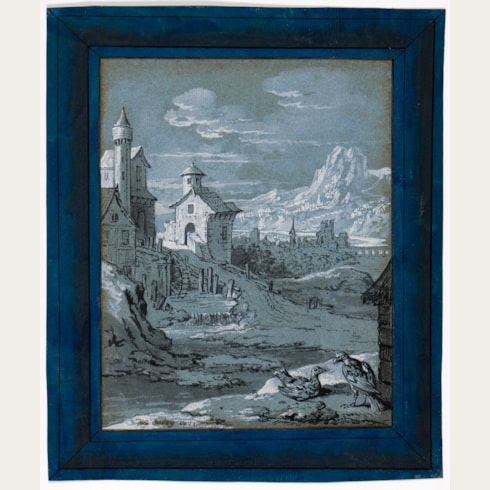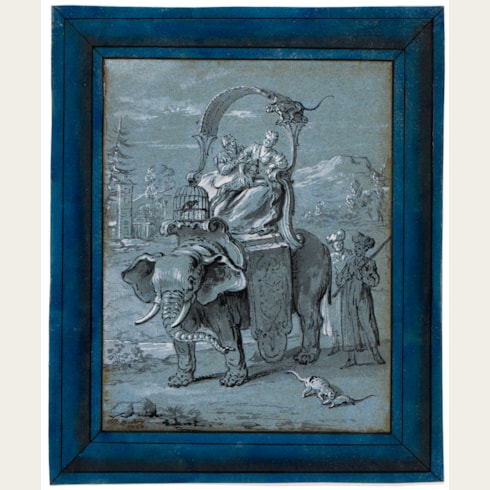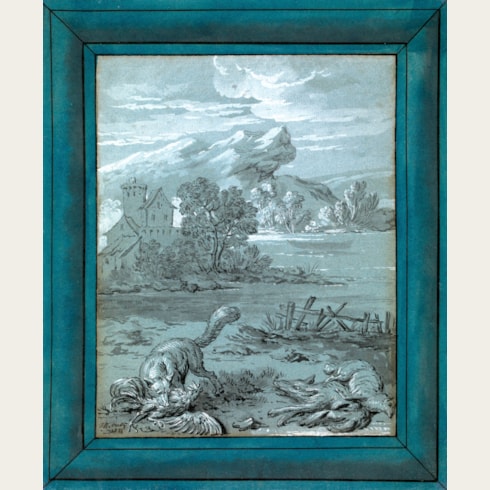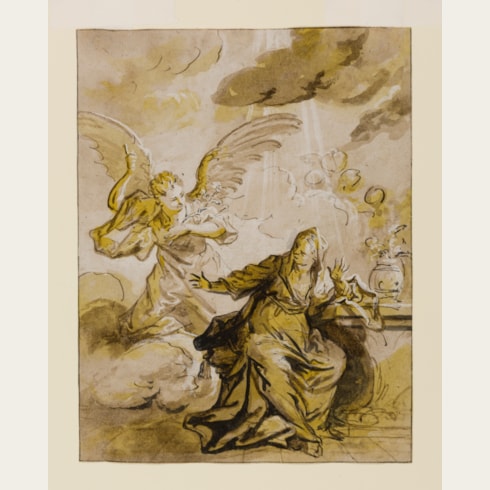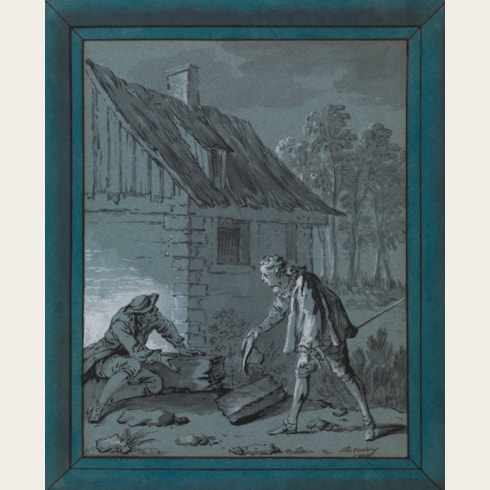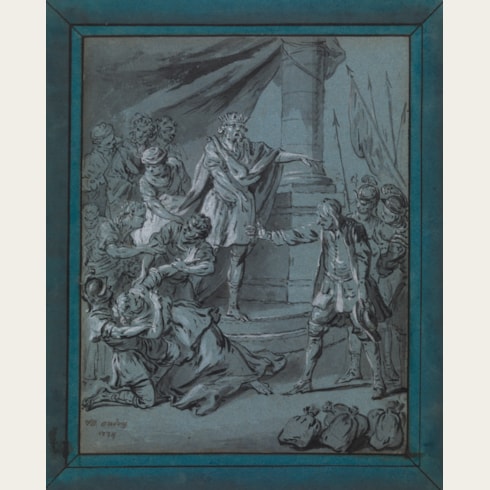Jean-Baptiste OUDRY
(Paris 1686 - Beauvais 1755)
Belphegor, A Tale by Machiavelli: Roderic and Honnesta
Sold
Brush and black ink and grey wash, heightened with white, within a simulated mount drawn in blue and grey wash with pen and brown ink, on blue paper.
Signed and dated JB. Oudry / 1734 at the lower left.
Inscribed 133. tom.2 on the verso.
239 x 188 mm. (9 3/8 x 7 3/8 in.) [image]
307 x 259 mm. (12 1/8 x 10 1/4 in.) [with fictive mount]
Between 1729 and 1734, Jean-Baptiste Oudry produced a total of 276 superb, highly finished drawings, including a frontispiece, which illustrated 245 tales from the famous 17th century work by Jean de La Fontaine, the Fables choisies mises en vers (Selected Fables Rendered in Verse). Each scene was drawn with the brush with black ink and grey wash, heightened with white gouache, on sheets of blue paper, with each image surrounded with a wide border brushed on the same sheet in a darker shade of blue, acting as a fictive mount. The drawings, all made over this five-year period (with the exception of the frontispiece, which is dated 1752), have long been among the artist’s most famous works. Indeed, this complete set of illustrations to the Fables, as the Oudry scholar Hal Opperman has noted, ‘have done more to establish the image of Oudry that has come across the years, than any others of his productions.’ Nearly all of the drawings are signed and dated, and, to judge from the dates, the artist seems to have made the drawings in order, in the sequence that they appear in La Fontaine’s Fables. Oudry’s most ambitious undertaking as a draughtsman, the project to illustrate the Fables seems not to have been a commission, but instead was done on the artist’s own initiative, and his early biographer, the Abbé Louis Gougenot, notes that he worked on the drawings in the evenings.
The present sheet is one of four illustrations by Oudry depicting the story of Belphegor, presented as the 27th fable of Book XII of La Fontaine’s Fables. (The tale is derived from the 16th century novella 'Belfagor arcidiavolo' by Niccolò Macchiavelli, written between 1518 and 1527 and published in 1549.) As Opperman has noted, ‘This is a rather complex tale, not easy to illustrate in all its twists and turns. While the first and fourth drawings conform to events in a conventional narrative way, the middle two are of necessity less straightforward. Oudry did the best he could…The first scene sets the stage. At his court in Hell, Satan conducts a sort of poll of the damned, asking what it was that brought about their doom. A great majority assign the blame to their spouses. Hoping to capitalize on this finding to steer an even greater number of future souls to Hell, Satan and his council designate one of their number, the fallen angel Belphegor, as an envoy to the world, where he is charged to find a spouse, gain direct experience of matrimony, and bring back an explanation of why it is such an effective channel to perdition. This is the moment depicted in the first drawing.’
The first drawing in the sequence of four Belphegor episodes, which shared the same provenance as the present group of three drawings until 2002, is today in the collection of the J. Paul Getty Museum in Los Angeles.
The present sheet, the second in the sequence, continues the story. As Opperman writes, ‘The second scene characterizes the first phase of Belphegor’s embassy without directly depicting any particular event in La Fontaine’s poem. Belphegor, in the guise of a wealthy gentleman named Roderic, has settled in Florence where he is taken up in society and soon becomes a sought-after candidate for marriage. Above all the other eligible maidens he courts Honnesta, who plays hard to get and whose wily father exacts a munificent bride price. Roderic’s manipulative, quarrelsome, newly-won bride and her family reduce him quickly to abject misery. The second drawing shows the domineering Honnesta and the hapless, rueful Roderic.’
‘Jean-Baptiste Oudry is one of the most prolific artists – and without question the most versatile – of the French eighteenth century. Once established he was also one of the most successful of his time.’ Such is the Oudry scholar Hal Opperman’s succinct description of the artist, who enjoyed a successful career of more than forty years. A pupil of Michel Serre and Nicolas de Largillière, Oudry took classes in drawing at both the Académie Royale and at the Académie de Saint-Luc of the Parisian painter’s guild, where he also later taught. The early part of his career found the artist painting mainly still life subjects and portraits. Admitted into the Académie Royale in 1719, by the following decade Oudry had come close to supplanting Alexandre-François Desportes as the leading painter of animals and hunting scenes. He began receiving significant royal commissions for paintings of hunts, and in 1725 was granted lodgings in the Tuileries palace. (The following year, at the request of Louis XV, he exhibited twenty-six of his paintings - the entire contents of his studio – in the Grands Appartements at Versailles.) It was also in 1726 that Oudry was engaged as a designer at the Royal tapestry works at Beauvais, where his masterpiece was the series of huge painted cartoons for the Chasses royales de Louis XV tapestries, eventually woven at the Gobelins, for which he was paid some 52,000 livres over a twelve-year period. In 1734 he was named director of the Beauvais factory, where he in turn soon employed the young François Boucher as a designer. The last fifteen years of his career saw Oudry paint numerous easel pictures of hunting scenes, dogs, game pieces and still life subjects, many of which were shown at the Salons. In 1743 he was appointed a professor at the Académie, where he had taught since 1739, although he does not seem to have been an inspirational teacher, and his only real pupil of any note was his son, Jacques-Charles Oudry. Apart from the King, Oudry counted among his most significant patrons the Swedish ambassador, Count Carl Gustaf Tessin, and the Duke of Mecklenburg-Schwerin.
Oudry was a prodigious draughtsman, and drawings were an integral part of his artistic practice. Although the 18th century art historian Antoine-Joseph Dezallier d’Argenville wrote of him that ‘His finished drawings are all in black chalk, highlighted with white using the brush [and] his studies are also in black chalk, highlighted with white chalk’, and while it is certainly true that black and white chalks were his favoured medium as a draughtsman, Oudry worked also in pastel, red chalk, brown ink and sepia wash. While the Oudry scholar Hal Opperman catalogued around a thousand drawings by the artist, many of these were only known through descriptions in old auction catalogues. While Oudry parted with some drawings in his lifetime, the vast majority of his output as a draughtsman – mainly studies of animals and birds, highly finished landscapes and book illustrations, carefully organized into albums - remained in his studio until his death.
Provenance
Sold by the artist, together with all of his drawings illustrating the Fablesof La Fontaine, to Jean-Louis Regnard de Montenault, in c.1751
Included in one of two albums containing all of Oudry’s drawings for the Fables of La Fontaine, with the booksellers Jean-Jacques and Marie-Jacques de Bure (Frères de Bure), Paris, by 1828
Jean-Jacques de Bure, Paris
His sale, Paris, 1-18 December 1853, lot 344 (bt. Thibaudeau for 1,800 francs)
Comte Adolphe-Narcisse Thibaudeau, Paris
Possibly given by him to the actress Mme. Eugénie Doche, and then sold by her for 2,500 francs to the bookseller Auguste Fontaine, Paris
Acquired from them for 5,000 francs in 1856 by Solar Aaron Euryale, known as Félix Solar, Bordeaux
His sale, Paris, Charles Pillet, 19 November – 8 December 1860, lot 627 (sold for 6,100 francs to Cléder for Baron Taylor)
Baron Isidore Taylor, Paris
Émile Pereire, Paris
The booksellers Damascène Morgand and Charles Fatout (Morgand et Fatout), Paris, probably by 1876
Acquired from them for 30,000 francs by Louis Roederer, Reims, by 1877
By descent to his nephew, Léon Olry-Roederer, Reims and Paris
Sold through Thomas Agnew and Sons, London, to Dr. A. S. W. Rosenbach, Philadelphia, in 1922
The Rosenbach Company, Philadelphia
Acquired from them by Raphael Esmerian, New York, in c.1946
His sale, Paris, Palais Galliera [Ader Picard Tajan], 6 June 1973, part of lot 46 (two albums sold for 2,000,000 francs)
One album with Art Associates Partnership (Dr. Claus Virch), New York and Bermuda, by whom the album disbound and the drawings contained therein – including the present sheet – thence sold separately
Private collection, Geneva
Adrian Ward-Jackson, London
Kate de Rothschild, London, and Didier Aaron Inc., New York, in 1993
Private collection.
Literature
Louis Gougenot, ‘Jean-Baptiste Oudry’, Mémoires inédits sur les artistes français, 1854, Vol.II, pp.379-380; Baron Roger Portalis, Les dessinateurs d’illustrations au dix-huitième siècle, Paris, 1877, Vol.II, pp.483-489; Bulletin de la Librarie Morgand et Fatout, Vol.I, 1876-1878, no.2904; Jean Locquin, ‘Catalogue raisonné de l’oeuvre de Jean-Baptiste Oudry, peintre du roi (1686–1755)’, Archives de l'art français, 1912, pp.152-173, nos.933-1209 (this drawing p.173, no.1206); Marquis de Girardin, ‘L’édition des fables dite d’Oudry de La Fontaine’, Bulletin du bibliophile et du bibliothécaire, 1913, pp.330-332; Roger Gaucheron, ‘La preparation et le lancement d’un livre de luxe au XVIIIesiècle. Les Fables de La Fontaine, dites d’Oudry’, Arts et métiers graphiques, December 1927, pp.77-82; Hal N. Opperman, Jean-Baptiste Oudry, Ph.D dissertation, University of Chicago, 1972 (pub. New York and London, 1977), Vol.II, p.710, no.D492; Horace Wood Brock, Martin P. Levy and Clifford S. Ackley, Splendor and Elegance: European Decorative Arts and Drawings from the Horace Wood Brock Collection, exhibition catalogue, Boston, 2009, p.156, no.105, illustrated p.108.
Exhibition
New York, The Pierpont Morgan Library, Fables from Aesop to Thurber, 1965 (as part of an album); New York, Paris and London, Kate de Rothschild and Didier Aaron at Didier Aaron, Inc., Master Drawings, 1993, part of no.15; Stanford University, Cantor Center for Visual Arts, Classic Taste: Drawings and Decorative Arts from the Collection of Horace Brock, March-May, 2000; Boston, Museum of Fine Arts, Splendor and Elegance: European Decorative Arts and Drawings from the Horace Wood Brock Collection, 2009, no.105.





